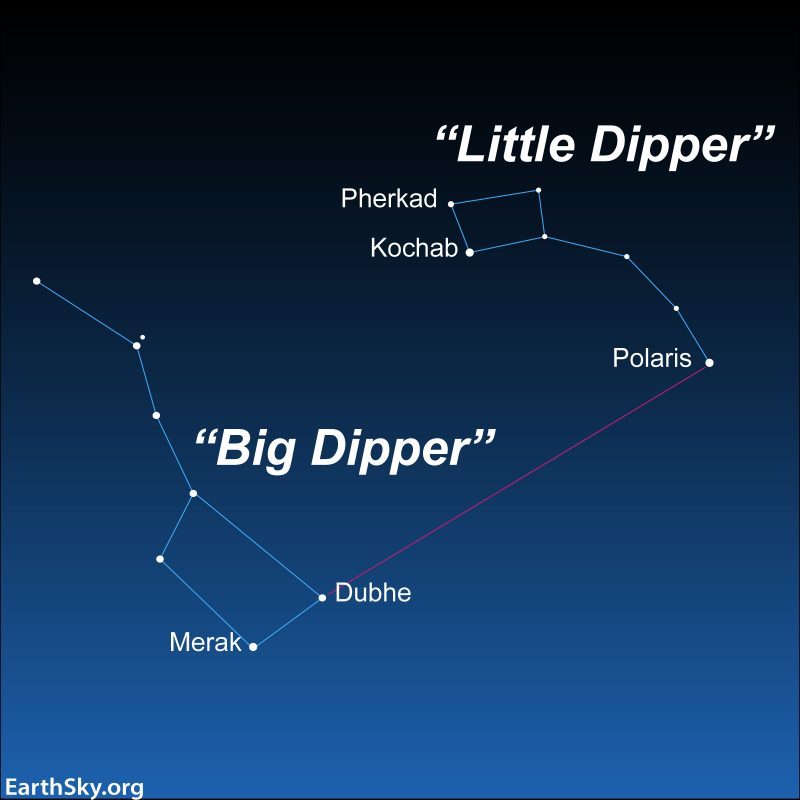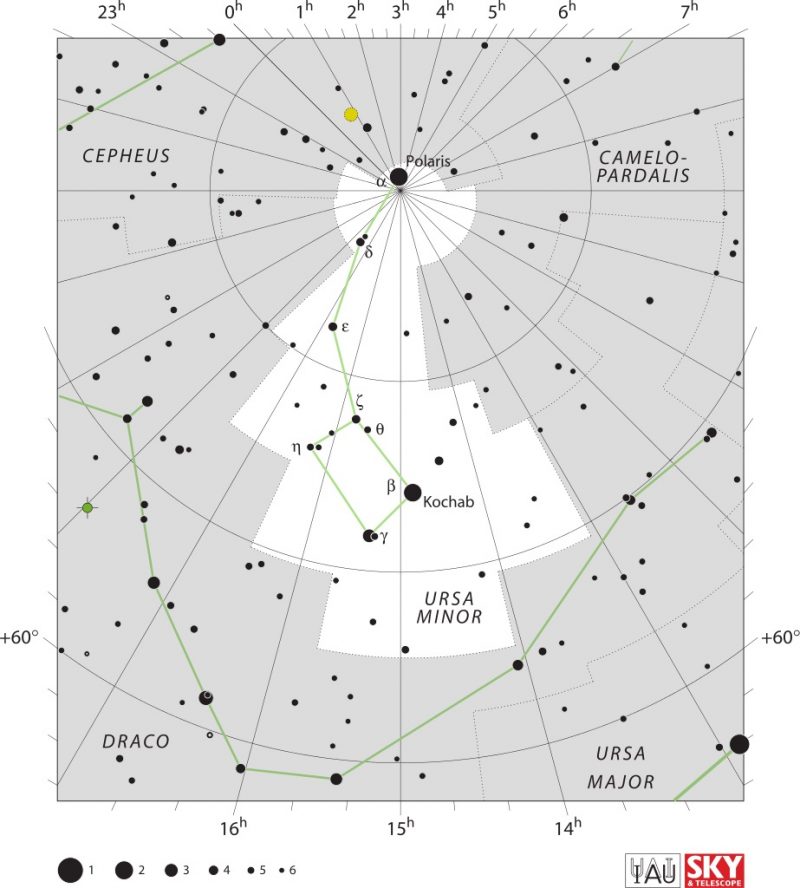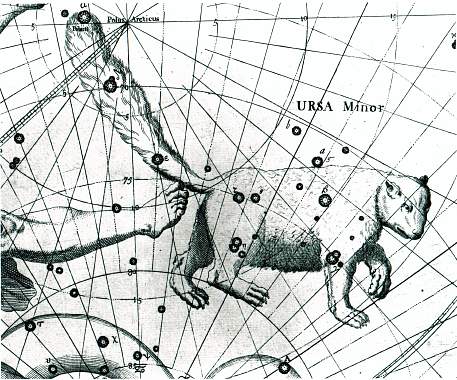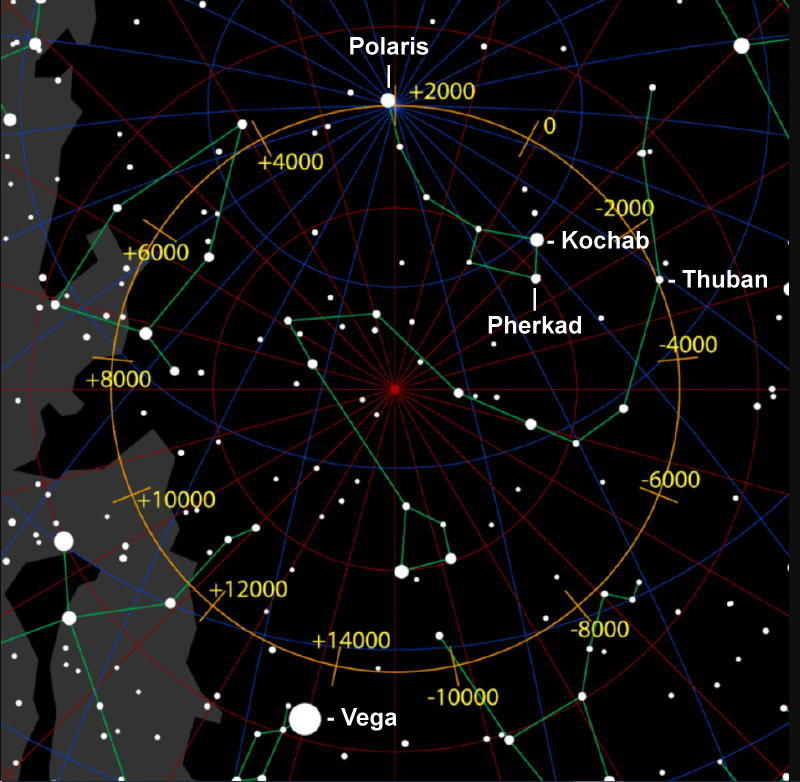
Kochab and Pherkad are part of the famous Little Dipper asterism in the constellation Ursa Minor the Lesser Bear. They mark the outer part of the cup of the Little Dipper, the part farthest from Polaris, the North Star. Kochab has the designation Beta Ursa Minoris, and Pherkad is Gamma Ursa Minoris. Their proximity to the famous Polaris might cause you to overlook them, but Kochab and Pherkad have their own claims to fame.

How to see Kochab and Pherkad
Because they are so close to Polaris and the north celestial pole, you can see Kochab and Pherkad every night of the year from the heavily populated areas of the Northern Hemisphere, and at some times from as far south as Brazil, much of Africa and far northern Australia.
For northern observers, you can see these stars at any hour of the night, any night of the year, but it’s best when they’re high overhead on midsummer evenings.
Finding this pair is easy, if you look first for the Big Dipper and then Polaris. Use the two outer stars in the bowl of the Big Dipper to find Polaris, which marks the end of the handle of the Little Dipper. Kochab and Pherkad are in the bowl of the Little Dipper. Along with Polaris, Kochab and Pherkad are the only stars of Ursa Minor bright enough to be easily visible from most urban locations.

Amateur astronomers aligning their telescopes use Kochab to help aim their telescopes to the true north. They start by finding Polaris, but Polaris is about 0.7 degrees off of true north. So, from Polaris, they aim 0.7 degrees in the direction of Kochab to center on true north.
Science of Kochab and Pherkad
Although they appear close together in our sky, Kochab and Pherkad are not related in any way, in space. Kochab lies about 130 light-years distant, while Pherkad is nearly four times farther at about 480 light-years.
Both are giant stars, larger and brighter than our sun.
Although not as hot as the sun, Kochab is roughly 40 times larger in diameter, and 390 times more energetic. In fact, if placed where our sun is now, Kochab would extend nearly to the planet Mercury. David Darling says that Kochab has exhausted its core supply of hydrogen and is an evolving orange giant star probably at the stage of helium-burning.
Pherkad is not as large (a mere 15 times larger than our sun), but because it is much more massive and hotter than our star, it pumps out energy at 1,100 times the rate. Actually, we should refer to it as Pherkad A to distinguish it from a nearby faint star, Pherkad B (the star known as 11 Ursae Minoris). These two are not related gravitationally, either, by the way. Pherkad B is barely visible to the unaided eye under very good dark sky conditions. It is six times fainter than Pherkad at magnitude 5.0 and sits 17 arcminutes, about a quarter of a degree, to the west of its brighter neighbor.
Visually, Kochab is magnitude 2.08. So most of the time it is fainter than Polaris, which varies between magnitude 1.86 and 2.13. But sometimes, when Polaris dims, Kochab becomes the brightest star in Ursa Minor. Pherkad is more than twice as dim as Kochab at magnitude 3.00. Both are easily visible from dark locations with low light pollution.

Guardians of the Pole
Continually circling around Polaris, near the north celestial pole, Kochab and Pherkad are often called Guardians of the Pole.

The name Kochab comes from an Arabic title that apparently refers to its nearness to the north celestial pole, and, in fact, about 3,000 years ago it was closer to the pole than Polaris. Kochab was known as the pole star and sometimes called Polaris between 1700 BCE and 300 CE. The closest the north celestial pole came to Kochab was 7 degrees.
At times, Kochab and Pherkad were seen as two calves because they keep as close to the pole as calves to their mother. The name Pherkad appears to be derived from an Arabic term for calf.
Kochab’s position is: RA: 14h 50m 42.3s, dec: +74° 09′ 20″
Pherkad’s position is: RA: 15h 20m 43.7s, dec: +71° 50′ 02″
Bottom Line: The Guardians of the Pole, Kochab, and Pherkad, bright stars in the Little Dipper, are easy to find. These two massive stars are always above the northern horizon as seen from most of the Northern Hemisphere.











